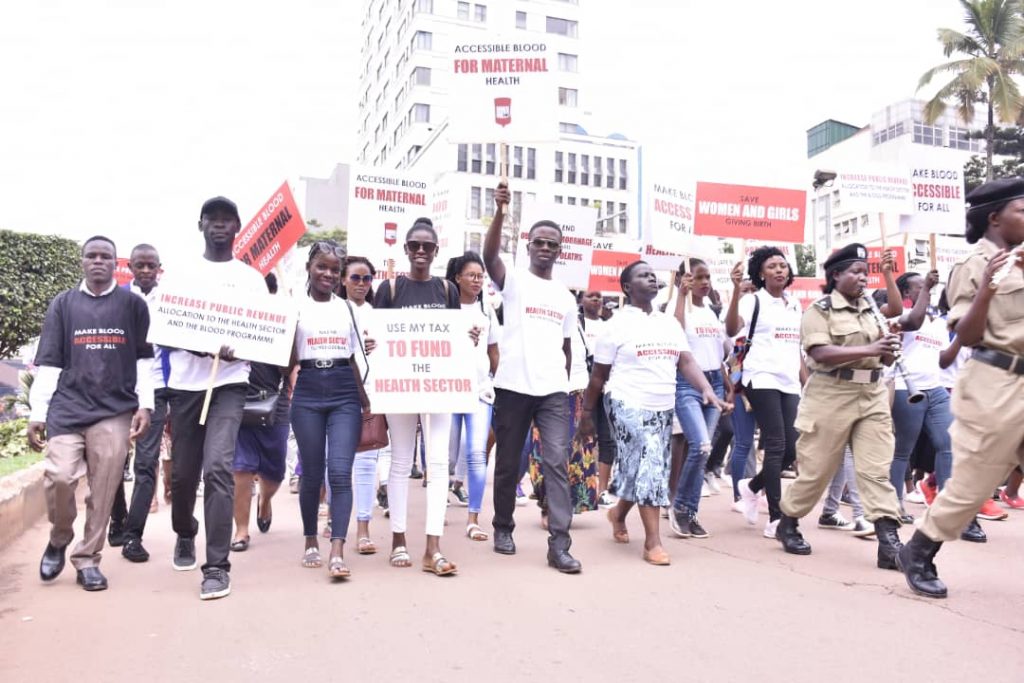by Rik Linssen and Saskia van Veen

Public procession in Kampala City during the campaign to fund the blood bank
Photo credits: Ms. Faith Nabunya, 2020
Mobilising citizens to raise their voices and hold those in power to account for their actions is one of the main ways Oxfam fights poverty and inequality. Oxfam amplifies the voices of those living in poverty and injustice. By mobilising citizens in various modes of collective action (for example, signing a petitions, contacting authorities and CSOs, joining demonstrations) Oxfam raises citizens’ voices to hold those in power to account. But, who voices their concerns towards those in power? Who is less likely or refrains from raising his or her voice?
In the programme ‘Towards a worldwide influencing network’, Oxfam Novib and the Centre for Research on Multinational Corporations (SOMO) partnerred with the Dutch Ministry of Foreign Affairs to tackle injustices that cause and perpetuate poverty. The focus in this programme was to raise citizens voices on critical issues like conflict and fragility (C&F), the right to food (R2F), and securing the financing needed for development (F4D). The programme was implemented in 17 countries between 2015-2020. We combined scale survey data from more than 4600 respondents who participated in 9 projects in Uganda, Vietnam, the Occupied Palestinian Territories (OPT), Myanmar, Burundi, Niger, and Cambodia, collected in 2019-2020 within the Strategic Partnership.
This blog shows the main highligts of the study, more information can be found in the full paper.
Who raises their voice and takes action?
The surveys inquired whether citizens targeted in our projects did or did not engage in 17 types of citizen actions –(ranging from attending community discussions, raising issues with government authorities, contacting CSOs, to singining (online) petitions. These surveys also collected data on the socio-demographic background of the people targeted in our project as well as a set of attitudinal characteristics such as trust in institutions, norms about participating in activities of CSOs and feelings of efficacy. We analysed whether people did or did not engage in any of those modes of citizen action. The statistical analysis used to estimate or ‘predict’ how likely it is that someone with a particular view or characteristic – for instance someone who is likely to trust INGO’s – takes any form of citizen action. By doing so, we can investigate how socio-demographics and attitudinal determinants relate to citizen action and find out who is most likely to raise their voice and who is less likely to take action. By combining these large scale surveys we investigate the commonalities across projects in the type of people who raised their voice and the attitudes they held.
Which socio-demographic groups are likely to raise their voice and hold those in power accountable?
We find that men, older people and people with high levels of education are more likely to raise their voice. This is consistent with the literature on political participation and modes of civic engagement more broadly (for example, Brady et al., 1995), which argues that those with more resources and skills to participate – i.e. the higher educated – are more likely to participate. Older people are also more likely to raise their voice. On the other hand, women are less likely to engage in any action than men.
These patterns are consistent for each mode of citizen action (ranging from attending community discussions to signing petitions to attending demonstrations) and each theme the projects focused on (right to food, conflict and fragility, and finance for development).
Feelings of efficacy

Feelings of (political) efficacy and interest in politics are the most critical drivers of active citizenship, particularly for women. Feelings about whether changes within one’s communities are possible and whether someone considers themselves capable to play a social role is particularly important for women (See figure). Although women are generally less likely to participate in any form of citizen action, Women who feel that ‘people like themselves’ can generally change things in their community, ‘very easily’ are 1.5 more likely to have taken any type of citizen action than women who feel it is not at all possible to change things in their community.
What can we do with this information?
Overall, these results showed that the locus of active citizenship in the programme was at the community level – mobilizing men, older people, and higher educated people to raise their voice on critical issues. Despite the wide variety of projects, types of action and contexts in which these projects were implemented, how these determinants shaped active citizenship was surprisingly consistent. Efficacy, or the extent to which people felt that change was possible within their own community, was the most important determinant.
Thus, programmes that aim to mobilise citizens to take action should focus their efforts as close to the people they seek to mobilise as possible, stimulate citizens’ confidence in their own ability to make changes in their communities and seek to engage citizens in partnership with the people and institutions they trust, such as traditional and religious leaders.
About Authors:
Saskia van Veen is a senior impact measurement & knowledge specialist focused on mixed-methods research, qualitative and participatory research, and learning. She is part of the Learning, Innovation, and Knowledge unit at Oxfam Novib.